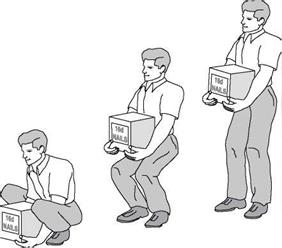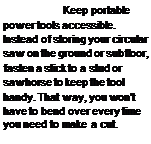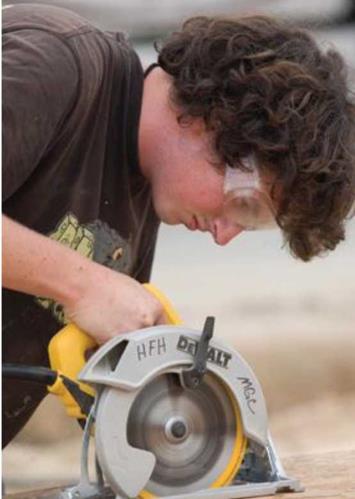WORKING SAFELY ON A CONSTRUCTION SITE





![]()
Working on a construction site is not a sunny stroll in the park. There are all kinds of unusual, uncomfortable, and potentially hazardous conditions you may encounter—uneven ground, troublesome weather, boards with protruding nails, and sloped roof surfaces that challenge your balance. Learning how to work safely and effectively in a construction environment is just one more skill that you need to acquire, such as hammering a nail or sawing a board. Here are some basic suggestions to keep you safe and productive:
■ Wear good shoes, clothes that fit well, longsleeved shirts, long pants, a hat with a brim, and sunscreen. (see Resources on p. 279). Leave jewelry at home, and bunch up long hair, so it doesn’t get caught in a power tool.
■ Protect your eyes with safety glasses or goggles when sawing or nailing.
■ Protect your ears. Hearing damage is cumulative and permanent; once you’ve damaged your ears, you can’t undo it. I keep a few sponge earplugs in a 35mm film canister stored in my tool bucket.
■ Protect your lungs with a dust mask.
■ To prevent back injuries, remember to lift with your legs, not your back. If you’ll be working on your knees, wear kneepads.
■ To reduce the risk of tripping or stepping on a nail, keep your work area clean.
■ If you see any nails sticking out of boards, either bend the nails or remove them.
■ Never throw anything off a roof without looking to see whether anyone is below.
■ Don’t drink (or do drugs) while doing construction work.
■ No one under 18 years of age should be permitted on a construction site with hazardous materials.
■ No one under 16 years of age should ever be permitted on a construction site.
■ Work with a clear head and pay attention to what
you and others around you are doing. Be especially careful toward the end of the day, when you are physically tired.
■ Pay attention to your inner voice. If you feel that something might be dangerous, ask for help or figure out a better way to do it.
■ Don’t forget to rest and drink plenty of water. Your body can become dehydrated rapidly on a hot, dry day. If you aren’t visiting the Porta Potti® regularly, you aren’t drinking enough water.
■ Keep your tools sharp and clean, take care of them, and treat them well.
■ Take a courseinbasic firstaid.


you to carry many individual tools. For organizing specialized tools (collections of drill bits, chisels, or screwdrivers, for example), inexpensive storage boxes in many sizes are available from supply stores. Label the boxes so you know what’s inside.






Leave a reply